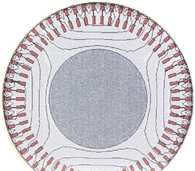| enginuity |
|
Model motors
A typical household in Britain will contain between 40 and 50 electrical motors, so it is little wonder that the Electrical Power group under the leadership of Professor Steve Williamson is heavily involved with the manufacturing industry. 'We transfer knowledge to the motor manufacturing industry,' says Professor Williamson. 'In my view, electrical power engineering is the enabling technology of this century. Electrical machines determine the generation, transportation and usage of electricity. Improvements in the efficiency of the running and manufacture of motors can therefore have an enormous impact. By using finite-element analysis to produce very accurate computer models of these complicated and intricate devices, we are looking to produce design changes that are revolutionary rather than evolutionary.'

Such models, as well as being used to assess the effect of design changes on a motor, can also be used to simulate how a machine works under fault conditions. 'Condition monitoring has now become a useful tool in production lines. If a sensor detects a fault in the current waveform of a working machine, then the simulation of working with such a fault can be used to provide advice regarding what action to take. Other uses are to determine the effect on a product of manufacturing to the extremes of tolerances. This can lead to both improvements in efficiency and more realistic manufacturing tolerances without incurring expensive mistakes,' Professor Williamson explains. 'The first thing to do in all these cases is to improve the modelling and then apply "what ifs" to assess the effect of design changes, changes in manufacture, or faults during operation. Assessment of the effect of changes on the mode of operation can also lead to self-diagnosis, which is becoming increasingly important. If the models are such that performance predictions can be made only to within 10%, then one can only design to within that margin of error. That is why more accurate computer modelling is required.'
| number 4, spring '95 |